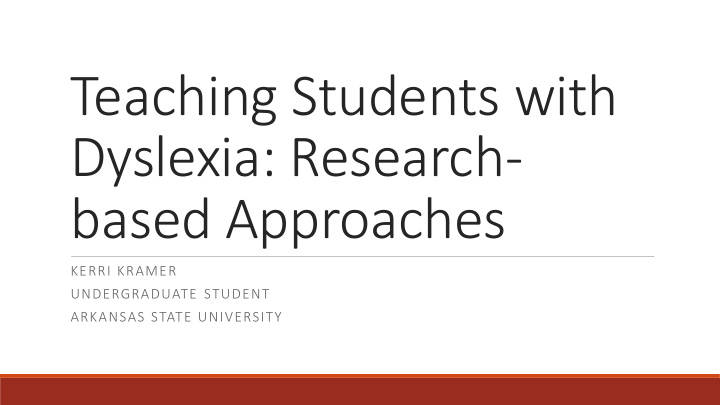



Teaching Students with Dyslexia: Research- based Approaches KERRI KRAMER UNDERGRADUATE STUDENT ARKANSAS STATE UNIVERSITY
Dys-lex-ia A word meaning “difficulty with language” or “difficulty with words”, from the Greek morphemes “ dys ” and “ lex ” Synonymous with “specific reading disability”– a problem learning to read that is unexpected in relation to experience, originating in neurobiological differences in the way the brain processes language
We Used to Think Dyslexia meant “seeing things backwards” Dyslexia affects boys more than girls Dyslexia only occurred in “average to above average” children Left handedness predicted dyslexia We couldn’t diagnose dyslexia until after first grade was completed
What is Dyslexia?
How many people have reading disabilities? Reading Disabilities in Boys and Girls According to the National Institutes of Health 18 (NICHD Branch)… 16 14 ◦ 17% of children have difficulty learning to read 12 ◦ Girls are just as likely to be affected as boys 10 8 6 4 2 0 % affected boys girls
Not dependent on socioeconomic status Who is affected Not dependent on intelligence (can be gifted and dyslexic) by reading disabilities? Not dependent on parent’s level of education Dyslexia is a difference in the way the brain processes information. It is influenced by heredity.
The Cognitive Characteristics of a Poor Reader Specific weaknesses in phonological processing, letter knowledge, and alphabetic understanding predict reading outcomes for K-2 Vocabulary, knowledge of literate language (as children get older) “lower level” processing difficulties with the alphabetic code: ◦ Phoneme awareness ◦ phonological memory ◦ Letter naming speed ◦ Knowledge of sound-symbol correspondences ◦ Accuracy and fluency of work recognition
Aspects of Phonological Processing Phonological awareness Phonological retrieval Phonological memory ◦ encoding ◦ storage of words ◦ digits ◦ letters Novel word repetition Speech production of single phonemes and phoneme sequences
The Brain of a Person With Dyslexia Activates Different Areas NON-DYSLEXIC DYSLEXIC The brain of a normal reader (or non-dyslexic) The brain of a dyslexic reader activates activates at the back. primarily in the front.
Children Do Not Catch Up Once children fall behind, they are likely to stay behind and the gap is likely to widen. Supporting studies: C. Juel, 1994 (Harvard Graduate School of Education)J. Torgesen, K. Stanovich, F. Vellution (NICHD)A. Biemiller (Toronto)R. Good, E. Kame’ennui , D. Simmons (U. of Oregon)S. Shaywhitz and J. Fletcher (Connecticut Longitudional Study)
Grades K-2 Symptoms Trouble segmenting and blending sounds Poor letter-sound recall Poor application of phonics Inconsistent memory for words and lists Mispronouncing words Inability to spell phonetically ◦ Difference between BAT and CAT
Grades 3-4 Symptoms Phonic decoding is a struggle Inconsistent word recognition Poor spelling, dysphonetic Over-reliance on context and guessing Trouble learning new words (spoken) Confusion about other symbols
Grades 5-6 Symptoms Poor spelling, poor punctuation Reverts to manuscript from cursive Organization of writing is difficult Decodes laboriously, skips unknown words Avoids reading, vocabulary declines
Grades 7-8 Symptoms Slow reading, loses the meaning Persistent phonological weaknesses, less obvious Poor spelling and writing Confusions of similar words Does better with structured, explicit teaching of language
Grades 9+ Symptoms Trouble with foreign language study Writing and spelling problems persist Reading is slow and labored, can’t sustain Longer writing assignments very difficult Can cope when given extra time, study strategies, and structured language teaching
Are Dyslexic Poor Readers Distinguishable from Other Poor Readers? 38% of all children are “below basic” on NAEP 44% are dysfluent on NAEP (study) 25% of the adult population in the US are functionally illiterate (U.S. Dept. of Labor) 70% or more of low socio economic status, minority children fall behind early and are not likely to catch up to grade level
Are Students With IQ Discrepancies (LD) Different From Other Poor Readers? In cognitive characteristics? In characteristics of reading, spelling, and writing behavior? In response to instruction?
Prognosis: Are Long Term Outcomes Distinctive for “LD” Defined Group? Children who are IQ-discrepant and IQ- consistent do not differ in the long-term development of reading ability. “Garden variety poor readers” are numerous and very much like those with certified reading disabilities.
In other words… There is every reason to intervene early with any “at risk” child for reading difficulty. Our goal is to change the prediction of long term outcomes. Children needing intervention should be identified in ways that do not require and IQ measurement.
References “Differentiation made among poor readers into dyslexics.” UKEssays , www.ukessays.com/essays/psychology/differentiation-made-among-poor-readers-into-dyslexics psychology-essay.php Sandman, Kelli. "What is dyslexia?" Youtube What Is Dyslexia - Bing video . N.p., n.d. Web. 25 Oct. 2017. <https://www.bing.com/videos/search?q=youtube%2Bwhat%2Bis%2Bdyslexia&view=detail&mid 773C8AADCF691E9735B9773C8AADCF691E9735B9&FORM=VIRE>. Foundations of Reading Text book Bing images
Recommend
More recommend